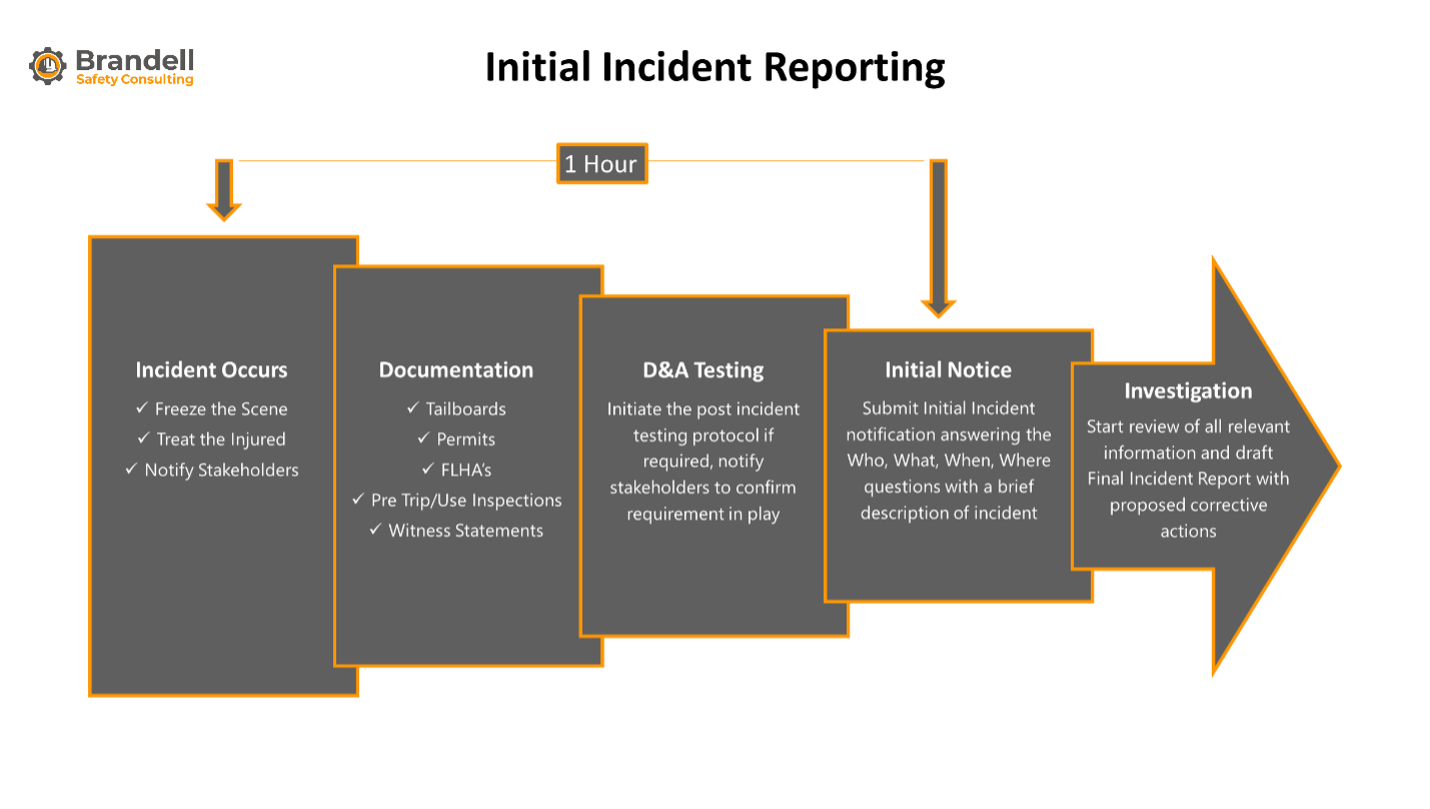
Tick, Tick, Tick,..
When an incident occurs on site, the clock starts, just like in the television show “48 Hours”.
In that timeframe, as a subcontractor, you’ll be required to
- Give initial notice, freeze the scene,
- Care for the injured,
- Collect Tailboard, Permits, FLHA’s from site,
- Submit an initial report,
- Initiate drug and alcohol testing protocol,
- Interview and obtain statements from witnesses,
- Assemble training records and employee signed documents from historical data,
- Perform an investigation to determine root causes,
- Develop SMART corrective actions and
- Submit the final report
 The scope of documentation that has to be collected and submitted for a project investigation should be no different than those used for an internal one. The difference is the timeline involved. An owner will typically expect a complete report with corrective actions from the prime contractor within 48 hours from time of incident. At the same time, the prime contractor will want to have time to review an incident if it involves a subcontractor company and expects that the latter will submit/provide a complete and final report including documentation within 24 hours. Have you ever done a TapRoot investigation from start to finish in under 24 hours?
The scope of documentation that has to be collected and submitted for a project investigation should be no different than those used for an internal one. The difference is the timeline involved. An owner will typically expect a complete report with corrective actions from the prime contractor within 48 hours from time of incident. At the same time, the prime contractor will want to have time to review an incident if it involves a subcontractor company and expects that the latter will submit/provide a complete and final report including documentation within 24 hours. Have you ever done a TapRoot investigation from start to finish in under 24 hours?
System Strength
To have even a chance at complying with these very tight timelines, companies must have a strong HSMS that provides the capability of retrieving historical data through filters arbitrarily placed on the system. The required information must be organized so that the individual’s past training, meeting attendance and signed documentation is available for review by stakeholders. Equipment maintenance records and manuals, Company Safe Work Practices, Procedures and Hazard Analysis will certainly have to accompany any written report in a serious incident investigation.
H&S Coordinators
With project investigations, H&S personnel of all levels must take responsibility, help the team assemble the evidence in short order and work towards the development and implementation of SMART corrective actions to prevent recurrence. Field coordinators need to be aware of their role on site to
- freeze the scene,
- enact the ERP if required,
- gather statements from personnel involved with or witnessing the incident,
- assemble the current documentation (e.g., tailboard and workers FLHAs),
- escort personnel to post incident drug and alcohol testing and
- get the information to the H&S Manager & team, to begin work on the reporting requirements
H&S Management
H&S Managers need to have a strong framework regarding initial and subsequent notifications, as well as communication to multiple stakeholders, both internally and externally.
Initial notice to the prime contractor should be an email, followed by a phone call to confirm. If cell coverage doesn’t allow for this, the H&S Manager must use alternate methods, such as a satellite phone or a two-way radio to provide the notification and stating that an initial report will be forthcoming. The email notification should contain only basic information, not presumptions or opinions on causal factors; just who, where, what time the incident occurred, number of Injured and whether outside resources are involved or have been notified.

H&S Team
Assemble the H&S team and review the incident as soon as possible. If specific documentation is missing or still unavailable, such as copies of the documentation from the site, note the items still to be reviewed and compile the initial report. Getting the initial report to the prime contractor will allow you to comply with the required timeline and will enable your team to continue with the review (without interruptions about when the initial report will be available, as the prime must also report to the owner within specific timelines). A word of caution regarding “filling in the blanks” on the initial report to make it appear as if you have the provided the facts. The benefits of this will be short-lived as you’ll be hoping that the information in the documentation is correct, but most times it won’t be. Report what you know and say that you’re continuing to look into the incident.
After reviewing all items that are available, comparing the witness statements and talking with the individuals directly to clarify any statements they have made, determine the root cause and develop corrective actions to propose to the prime contractor. Take the time to address the root cause of the incident and not simply propose training or punishment. The corrective actions will have to be implemented in a timely manner, addressing the root causes of the incident, so don’t submit vague actions that aren’t measurable or achievable.
Once you’re satisfied that you’ve determined the root cause and developed SMART corrective actions, write the report and submit it with all the supporting documentation in a zipped file to the prime contractor contact, as well as all of your internal management team, so that everyone is looking at the same information. Remember, time is critical here, as you must submit in a very short timeframe to be compliant. Don’t wait for more information to come in or multiple internal review meetings to occur. If you’ve followed the internal process that was developed before the project began, submitted all the available information for review, noting any forthcoming information that may affect the findings, then you can always revise the report at a later date as the information becomes available.
Having a well organized HSMS is the key to being able to deliver timely, accurate incident reporting. In summary, the HSMS is a tool that:
- includes field documentation creation and submission
- is a central data gathering and filing system that accepts all formats that are used on the project
- is a reporting/posting process that is automated to compile information from all departments
- can provide specific information when and where required


0 Comments